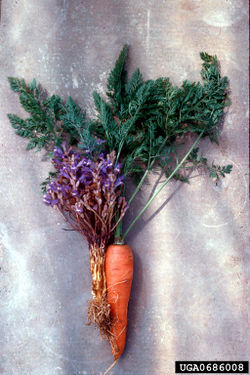Phelipanche (weeds)
| Literature database |
|---|
| 182 articles sorted by: |
| • year (descending) |
| • research topics |
| • countries/regions |
| • affected crops |
| • list of natural enemies |

Author(s): Reuven Jacobsohn, Agricultural Research Organization, Israel
Source: IPM Images
Phelipanche (Pomel) Sojak
This genus contains around 40 species of holoparasitic plants which are mainly found in subtropical and temperate regions. They do not produce chlorophyll and attach themselves to the roots of their host plants, obtaining water, minerals and nutrients from them. Several species are important agricultural weeds like Phelipanche aegyptiaca or P. ramosa. These parasitise a wide variety of crops.
The seeds are very small, typically < 0.5 mm long, and often with surface structures. The parasitic life cycle involves a) conditioning of the seeds in the soil, b) germination of the seeds in response to stimuli from the host plant, c) attachment of the parasite to the root of the host plant through a special structure (tubercle), d) development of the parasite.
Taxonomy:
Phelipanche is closely related to Orobanche and is regarded as a subgenus of that genus by some authors.
Currently, the following species have been entered into the system: